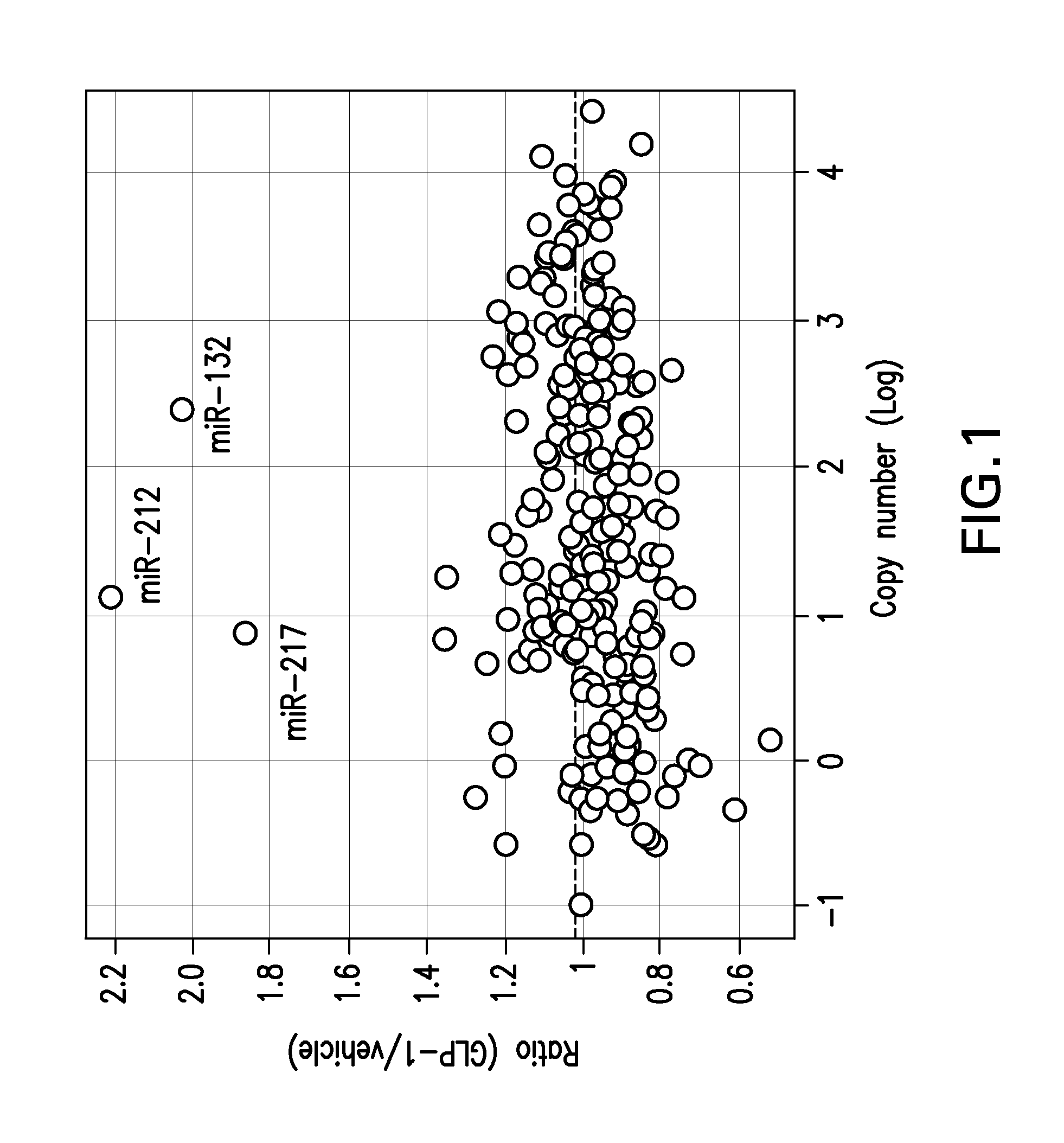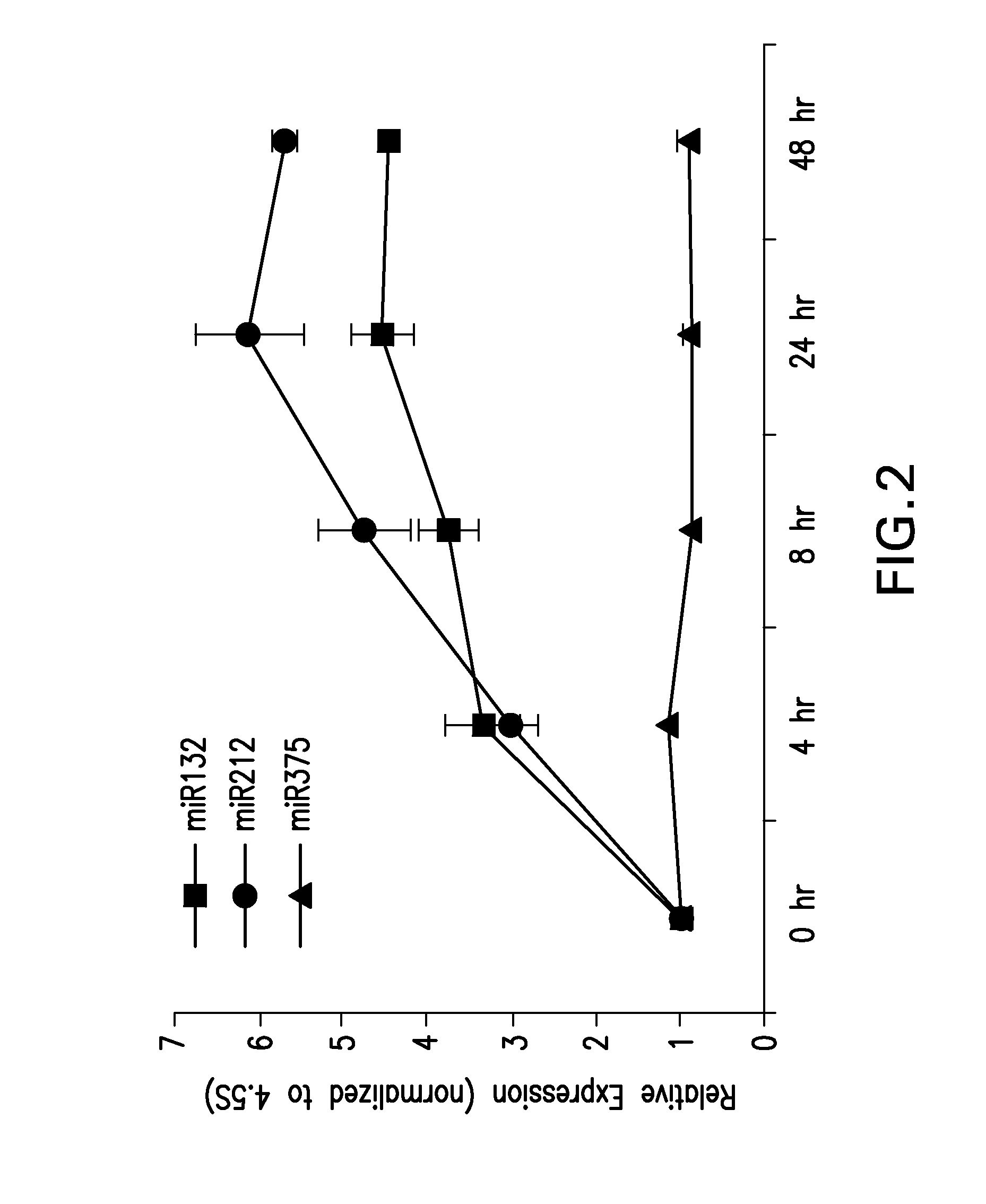Microrna as a biomarker of pancreatic islet beta-cell engagement
a pancreatic islet and beta-cell technology, applied in biochemistry apparatus and processes, drug compositions, metabolic disorders, etc., can solve the problems of hyperglycemia (abnormally high level of glucose in the blood), patients with high levels of these antibodies develop type i diabetes, and the amount of secreted insulin decreases
- Summary
- Abstract
- Description
- Claims
- Application Information
AI Technical Summary
Benefits of technology
Problems solved by technology
Method used
Image
Examples
example 1
[0097]Glucagon like peptide-1 (GLP-1) exerts pleiotropic effects on pancreatic β-cell function. GLP-1 potentiates glucose-dependent insulin secretion (GDIS) in pancreatic β-cells. Chronic administration of GLP-1 also promotes insulin synthesis as well as β-cell proliferation and neogenesis, at least in animal models. The detailed underlying mechanism remains to be fully understood. In this example, the expression levels of microRNAs in INS-1 832 / 3 cell, a clonal rat insulinoma cell line which exhibits robust glucose-dependent insulin secretion, was profiled. The expression levels of 250 microRNAs in INS-1 832 / 3 cell cultured in the presence or absence of 50 nM GLP-1 for 24 hours were compared using quantitative reverse transcription polymerase chain reaction (RT-PCR) method.
[0098]INS-1 832 / 3 and 832 / 13, two clonal rat insulinoma cell lines, which exhibit robust glucose-dependent insulin secretion, were obtained from Dr. Christopher Newgard at Duke University (Newgard et al., Diabete...
example 2
[0101]GLP-1-mediated regulation of miR-132 and miR-212 in INS-1 832 / 3 cells and rat pancreatic islets was confirmed with TAQMAN analysis.
[0102]INS-1 832 / 3 and 832 / 13 cells were maintained in RPMI 1640 with 10% FBS and 11 mM glucose. For GLP-1 treatment, GLP-1 (7-37) amide (ABCHEM) was added in the media in the presence of 16 mM glucose for 24 hours. Total RNA was extracted with TRIZOL as in Example 1. Rat islet isolation and treatment was as follows. Pancreatic islets of Langerhans were isolated from the pancreas of normal Sprague-Dawley rats (Charles River, Ind.) by collagenase digestion and discontinuous Ficoll gradient separation (15). Islets were cultured for 2 hours in RPMI 1640 medium with 11 mM glucose for recovery from the isolation process. Then 100-200 islets were treated with 50 nM GLP-1 in the media with 11 mM glucose for 24 hours. RNA was extracted with TRIZOL as in Example 1 for quantification of microRNA species.
[0103]TAQMAN real-time quantitative RT-PCR analyses conf...
example 3
[0107]This example shows that GLP-1 promotes the release of miR-132 and miR-212 from INS-1 832 / 3 cells in cell culture and the released miRNAs are detectable using quantitative real-time RT-PCR.
[0108]INS1 832 / 3 cells were treated with 50 nM GLP-1 (7-37) amide (BACHEM) in RPMI 1640 with 10% FBS and 11 mM glucose in 24-well plates for 4, 8, 16, and 24 hours. Cell culture media was collected, 100 μL out of 1 mL media per sample was used for RNA extraction following the protocol for plasma samples (Mitchell et al., Proc. Natl. Acad. Sci. USA 105: 10513-10518). Briefly, RNA isolation was performed using the mirVana PARIS kit following the manufacturer's protocol (Ambion), except that samples were extracted twice with acid phenol-chloroform. The average of about 80 μL of eluate was recovered from each extraction. A fixed volume of 1.67 μL of the RNA eluate was used as input into the reverse transcription reaction. RNA was reverse transcribed using the TAQMAN miRNA Reverse Transcription Ki...
PUM
| Property | Measurement | Unit |
|---|---|---|
| Level | aaaaa | aaaaa |
| Durability | aaaaa | aaaaa |
Abstract
Description
Claims
Application Information
 Login to View More
Login to View More - R&D
- Intellectual Property
- Life Sciences
- Materials
- Tech Scout
- Unparalleled Data Quality
- Higher Quality Content
- 60% Fewer Hallucinations
Browse by: Latest US Patents, China's latest patents, Technical Efficacy Thesaurus, Application Domain, Technology Topic, Popular Technical Reports.
© 2025 PatSnap. All rights reserved.Legal|Privacy policy|Modern Slavery Act Transparency Statement|Sitemap|About US| Contact US: help@patsnap.com



